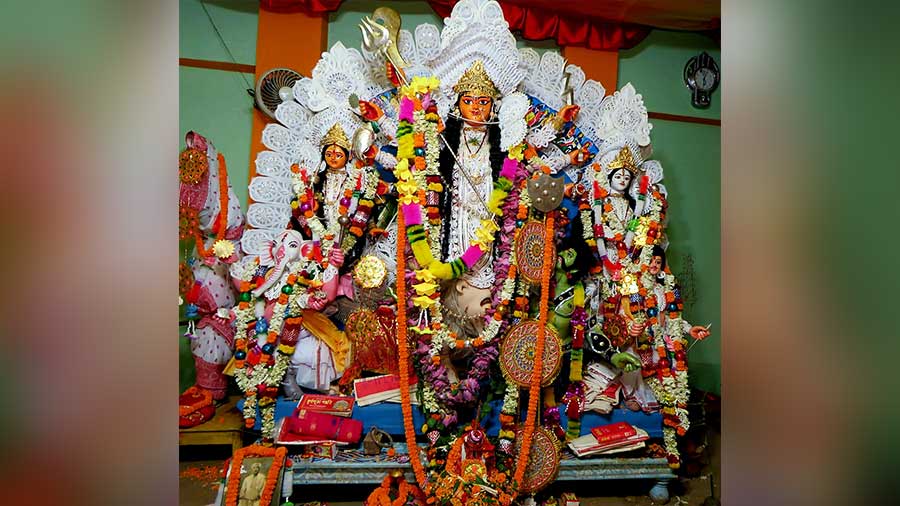All doors and windows of the Bhattcharya family’s five mansions in Hooghly’s Jorkul village are kept open at the time of sandhi pujo for Ma Durga to enter the houses.
The family started conducting Durga Puja around 1810 and ever since the puja has been dedicated to a grand old lady of the family named Ujjwalamoyee Devi, who many years ago requested his son to take her to the family puja of one Nantu Singh, a rich zamindar of Bhastara village.
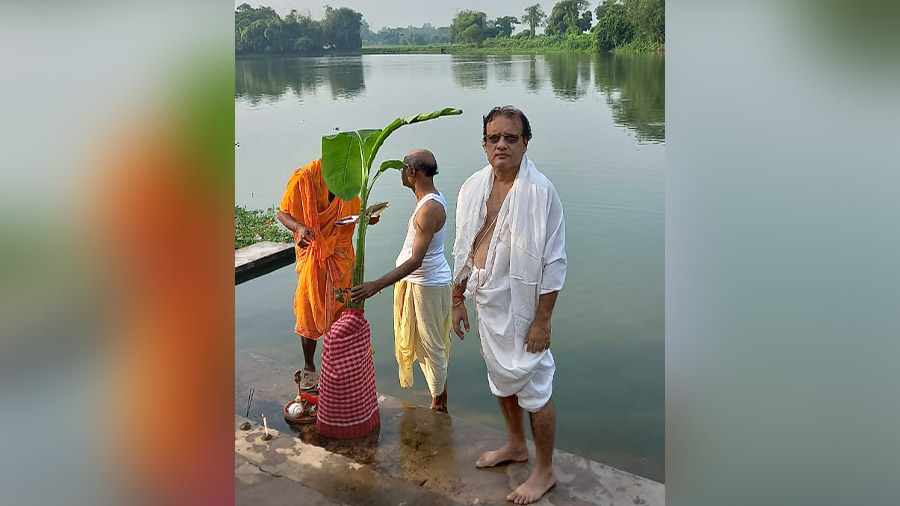
Bathing of ‘nabapatrika’ on Saptami morning
Moved by his mother’s desire to witness a Durga Puja in a rich man’s house, her son Haridas Bhattacharya, who had amassed a considerable amount of wealth by conducting business with East India Company in salt cargo coming from China in the early part of the 19th century, started Durga Puja at his ancestral home in Jorkul village of Hooghly. This is a unique tribute to a real-life mother while invoking the mother goddess.

Small-time trader Haridas’s fortune shone when he advised a British trader to buy a specific salt cargo coming on a ship from China. The Britishman earned so much from that shipment that he shared half the profit with Haridas to show his gratitude. With that money, Haridas bought zamindari in Hooghly’s Jorkul. Before that the family’s subsistence came from priesthood. This was the reason they earned the title ‘Bhattacharya’ and soon they discarded their old family surname Chattopadhyay and started using Bhattacharya.
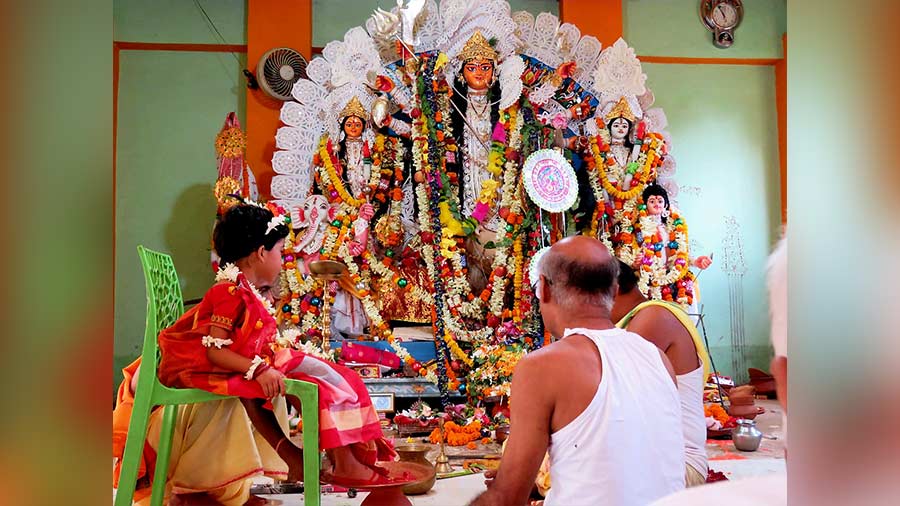
Kumari puja on Ashtami
Meanwhile, Haridas’s brother, Maheshchandra, and one of his sons, Amarendra, also did well in the business of trading sugar candy. The prosperity made the family grow and Durga Puja, though not very common among Brahmin families in Bengal, became a grand annual festival of the Bhattacharyas.
However, the family deity of the Bhattacharyas is Ananta Basudev and they have a family temple in which a unique image of Ananta Basudev is enshrined. The temple also houses a pair of wooden kharams which are believed to have been used by Chaitanya Mahaprabhu who touched the place while going to Puri from Nadia.
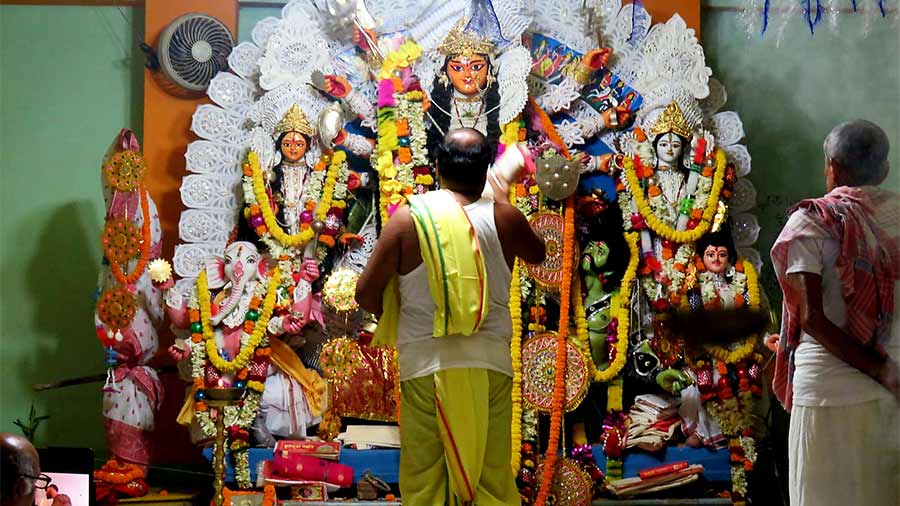
Priests performing evening ‘arati’
The ekchala idol is made in the typical West Bengal school of idol-making and it is made in the thakur dalan of the family house. The sculptor comes from the same family. One Kalipada Pal had made the idol for many years.
The festivities start with the worshipping of basic structure (kathamo) on the day of Rath Yatra and after that it is worshipped periodically till it is completed. In the state of incompleteness, the idol is wrapped in sari.
Being Brahmins, the Bhattacharyas enjoy the right to offer cooked naibedya to the goddess and on Ashtami, they offer naibedya made of 40kg of rice. The maha bhog is cooked by women of the family but carried to puja mandap by male members. Kumari puja is performed on Ashtami. Being worshippers of Krishna, they do not allow any animal sacrifice in puja and in their history of 200 more years, animal blood was never offered to Devi. No non-vegetarian food is offered to the Devi in any of the days though family members consume fish on Maha Sashthi, Maha Navami and mutton on Vijaya Dashami. Widows are allowed to participate in the puja but they do not take part in arranging puja materials.
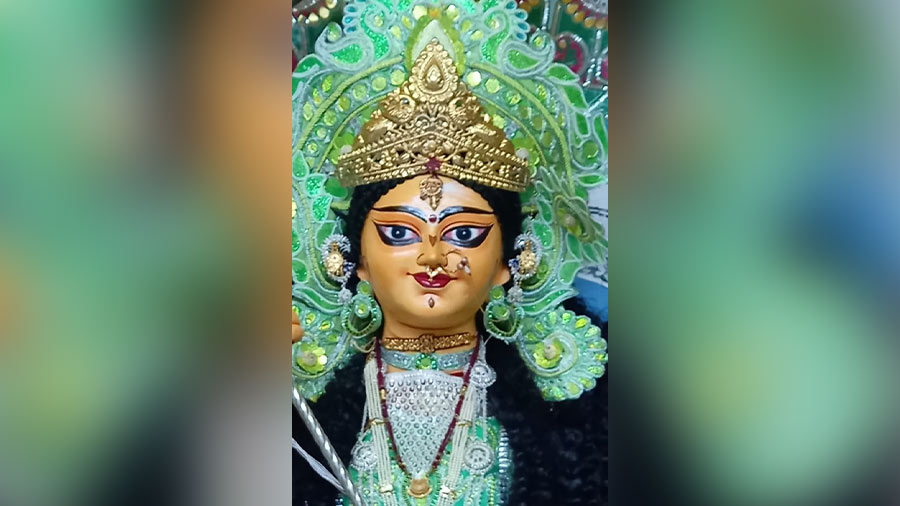
The mother goddess of the Bhattacharya family
The immersion takes place in a small water body inside the family property and the wooden structure after immersion is salvaged to reuse for the next year’s idol.
Abhijit Bhattacharya, one of the senior members of the family, recalls the late Amitabha Bhattacharya who made this family puja a great affair with indomitable vigour and zing. His death, as Abhijit thinks, was a setback. Abhijit, who is too proud to be a part of a rich family legacy, is more than excited about this puja which he will attend this year as well. He recalls his childhood nearly 35 years ago when from the station they used to take a bullock cart to reach the family house negotiating almost non-motorable roads. However, as he says, the joy of coming home to spend time with all family members was matchless.

Adieu to the Devi on Vijaya Dashami
